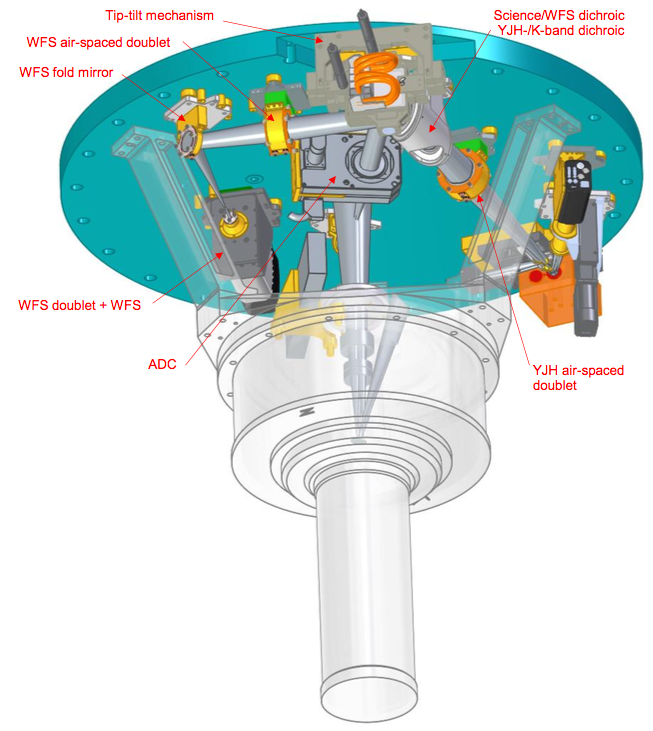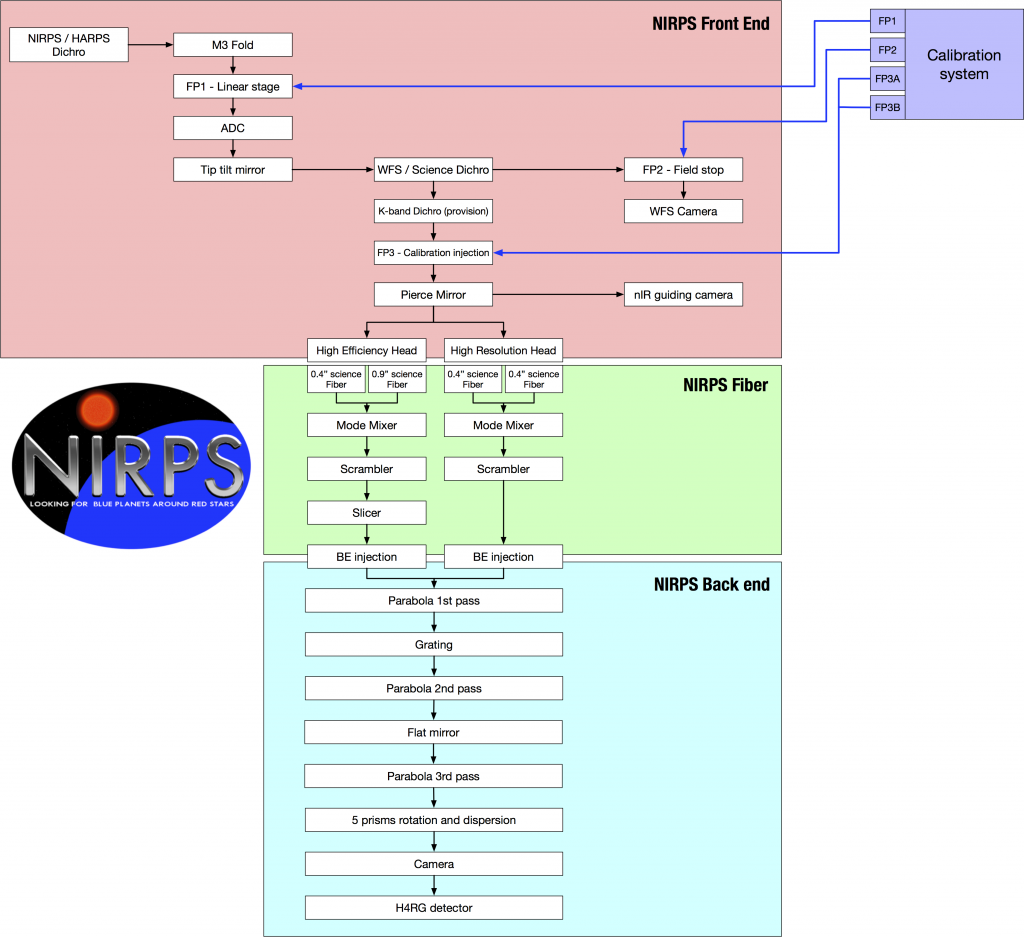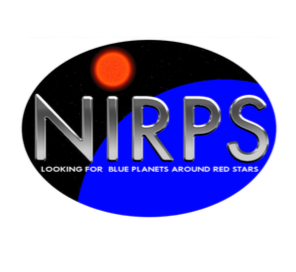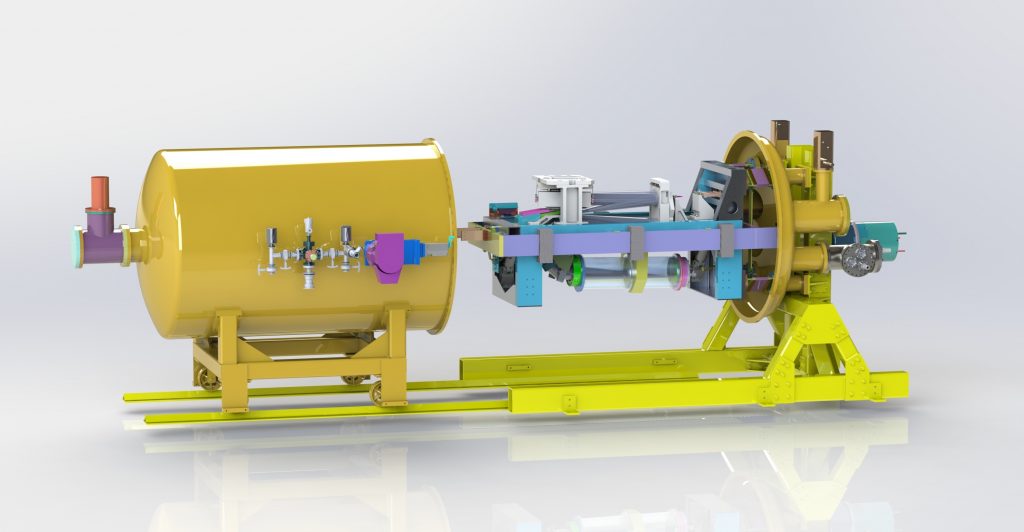Instrument
NIRPS is part of a new generation of Adaptive Optics (AO) fiber-fed spectrographs. Its originality resides in the use of a multi-mode fiber, much less affected by AO correction residuals than a single-mode fiber, allowing comparatively higher coupling efficiency in degraded seeing and on fainter targets, with relaxed AO specifications.
An Adaptive Optics fiber-fed spectrograph
NIRPS will mainly use a 0.4″ (29 µm at F/4.2) fiber, twice as small as what would be required for a seeing-limited instrument, allowing a spectrograph design that is half as big as that of HARPS, while meeting its high throughput and high spectral resolution requirements.
The AO system is designed around a 14྾14 Shack-Hartmann wavefront sensor operating between 700-950 nm, coupled to a 15྾15 deformable mirror with loop frequency of 250 to 1000 Hz. This high density of actuators and high speed are necessary to correct for high-order wavefront errors and to reach a high coupling efficiency. The AO will lead to a 50% efficiency for targets as faint as I=12 in median seeing conditions[14]. A 0.9″ fiber (66 µm @ F/4.2) will be used for fainter targets and degraded seeing conditions.
While a smaller fiber increases modal noise, NIRPS will use the many degrees of freedom offered by its AO system to properly scramble the stellar flux at the fiber’s entrance. This will be used in conjunction with three more scrambling methods: octagonal fibers, a fiber stretcher that modulates the phase between modes, and a double scrambler that exchanges the near and far fields.

Expected overall throughputs of NIRPS instrument, including atmosphere and telescope, with AO system as function of I magnitude for a median seeing of 0.9″ for the High Accuracy Mode (HAM) and the High Efficiency Mode (HEM).
A compact cryogenic echelle spectrograph
The entire optical design is oriented to maximize high spectral resolution, long-term spectral stability and overall throughput. Light exiting from either fiber links is collimated by a parabolic mirror used in triple pass and is relayed to an R4 echelle grating. The diffracted collimated beam is focused by the parabola on a flat mirror that folds back the beam to the parabola. The cross dispersion is done with a series of 5 refractive ZnSe prisms that rotate the beam by 180°. A 4-lens refractive camera focuses the beam on an H4RG 4096×4096 infrared detector. The instrument covers the 0.97 to 1.81 µm domain on 69 spectral orders with a 1 km/s pixel sampling at a resolution (λ/Δλ) of 100 000 (HAM) or 75 000 (HEM). The global throughput of the spectrograph alone is estimated to 30% and 45% at 0.97 and 1.81 µm, respectively. The spectrograph is installed inside a cylindrical cryostat (1.12-m diameter, 3.37-m long) maintained at an operating temperature of 80 K with a stability of 1 mK and an operating pressure of 10-5 mbar. The instrument will be installed on the East Coudé Room of the 3.6-m telescope.
While some nIR radial-velocity instruments have opted to cover the K (2.0-2.38µm) band, the decision was taken not to do so for NIRPS, favoring higher spectral resolution and simplicity. We nevertheless preserved the possibility of adding, at a later time, a K-band spectrograph in a separate cryostat; the common path of the NIRPS front-end, including the ADC, covers the K band.
NIRPS Back-end 3D opened view
The HARPS and NIRPS spectrographs can be operated individually or jointly. The default operation mode will have both instruments operating simultaneously except for high-fidelity polarimetric observations with HARPS-Pol. NIRPS and HARPS are fed by different fiber links permanently mounted at the Cassegrain focus; both instruments will have associated a High Accuracy and High Efficiency mode (HEM, HAM). For NIRPS, the HAM and the HEM respectively use 0.4″ and 0.9″ fibers, leading to spectral resolutions of R=100 000 and 75 000. The HEM uses a pupil slicer inserted in the double scrambler. Users can switch between modes anytime during night, and the mode used in one spectrograph does not constrain the mode used in the other spectrograph. Each mode is composed of two fibers, a science channel fed by the stellar beam and a simultaneous calibration channel fed by the background sky light or by a calibration lamp (Hollow-Cathode lamp, Fabry-Pérot, or Laser Frequency Comb). In principle, all the different configurations will be available and are technically possible for HARPS and NIRPS. The new front-end shown in Figure below includes all the opto-mechanical devices: 1) the VIS/NIR dichroic movable beam splitter to enable HARPS-only and HARPS-POL observations, 2) the ADC covering the 700-2400 nm domain, 3) the deformable mirror of the AO system mounted on the tip-tilt plate to compensate for any misalignment with HARPS, 4) the calibration sources injection for both AO wavefront sensor and NIRPS spectrograph, 5) the fiber selector allowing to select between the two the two modes, HAM and HEM, 6) a magnification selector to change the magnification / field-of-view of the NIR acquisition camera.

NIRPS Front End to be installed on the 3.6-m focus. The bottom pink part is the existing HARPS Cassegrain fiber adapter.
Summary of NIRPS characteristics
| Subsystem | Parameters |
| HAM-mode | Spectral resolution : λ/Δλ = 100 000
0.4″ object fiber, AO-assisted feed 0.4″ simultaneous reference fiber |
| HEM-mode | Spectral resolution : λ/Δλ = 75 000
0.9“ double slicing in the pupil plane 0.4“ simultaneous reference fiber |
| Environment | Vacuum : < 10-5 mbar
Cryogenic: 80 K with 1 mK stability |
| Spectral domain | 0.97-1.81 m (YJH photometric bandpasses) |
| Calibration sources | Hollow cathode lamp, Stabilized Fabry-Perot, LFC |
| Detector and format | Hawaii-4RG, 4kx4k, 15 µm pixels |
| Limiting magnitude | 1 m/s in 30 min for an M3 star with H=9 |
| Stability | <1 m/s intrinsic stability over one night.
Calibration down to <1 m/s over the lifetime of the instrument |
| Sampling | 1 km/s per pixel, 3 pixels per FWHM |
| Operation | Simultaneous operations with HARPS without degrading HARPS’ performances |
| Schedule | First light in 2019 |
NIRPS is composed of 4 subsystems
- The NIRPS front end is mounted on the 3.6m telescope rotator
- The NIRPS back-end which is the actual spectrograph is bolted to the floor of the Coudé EAST room
- The fiber link connects the front-end to the back end. It is attached to the telescope mount in the same way that the HARPS fiber link is attached and follows the same path to the Coudé floor apart from the fact that it goes to the Coudé EAST and not the Coudé WEST room.
- The calibration module, is contained in an electronic-type cabinet


